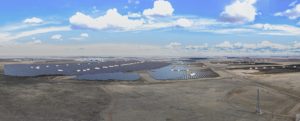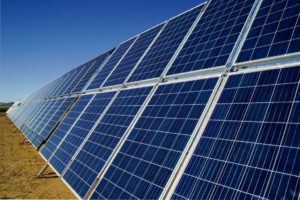Updated with related information 4 September 2023.
This post is contributed by Dr. Ian Urquhart who is Emeritus Professor of Political Science at the University of Alberta. He is the author of

Costly Fixpublished by University of Toronto Press in 2019.
Representing a local constituency – this duty distinguishes the responsibilities of a Canadian premier from their closest American counterparts, state governors. Premier Smith showed little concern for those responsibilities when she slapped an industry-wide seven month moratorium on approving new renewable energy projects. The billions of investment dollars put at risk by the moratorium includes hundreds of millions of dollars in solar for her constituency of Brooks-Medicine Hat.
DP Energy proposes to locate the $400 million Saamis Solar Park project in northern Medicine Hat. The project was very close to proceeding to a public hearing when the government threw its moratorium net over Alberta’s nascent renewables industry. When, or if, Saamis proceeds, it would provide 400 jobs and roughly $4.5 million annually in municipal taxes and lease payments.[1] The  Source: https://dpenergy.info/saamissolarpark/the-project
Source: https://dpenergy.info/saamissolarpark/the-project
Medicine Hat News suggested this would amount to three to four per cent of the City’s total annual tax income.[2] It would be a nice piece of change.
The government would have the public believe its moratorium is needed for a handful of reasons. Land usage and listening to municipalities are two prominent public rationales. Allegedly renewable projects take prime agricultural land out of production; allegedly municipal opinions aren’t considered sufficiently when the province considers these projects.
After looking at the AUC’s record of renewables approvals, I don’t believe there’s much substance to these rationales. But, even if there was some meat to them, neither justify the Premier’s de facto decision to delay a decision on the Saamis project until well into the spring of 2024, if not later. They simply don’t apply to the project.
Saamis Solar doesn’t covet agricultural land. Most of the project’s 6.6 square kilometre footprint would land on parcels the City of Medicine Hat zoned as “Light/Medium Industrial.” In turn, most of these acres constitute a “brownfield.” This term describes lands which have previously tasted industrial activity and may still host contaminants from that land use. In the case of Saamis, approximately 65 per cent of the project would be located on the former site of Viterra’s Westco fertilizer operation.
This location also won early approval from the Premier’s Environment department. Alberta Environment and Parks wrote Saamis to say it generally encouraged locating solar projects within urban boundaries “because urban solar projects typically have limited impact to wildlife and wildlife habitat…and they reduce the development pressure in locations with higher quality wildlife habitat.”[3]
As for municipal consultation, documents filed as part of the now-halted Alberta Utilities Commission hearing show at least six years of contact between the City and DP Energy about the Saamis project. The tone of those documents is positive, arguably glowing. The City appeared genuinely excited that DP Energy chose Medicine Hat, City officials also were pleased that the company decided to increase the size and electricity production of its project.
For its part, DP Energy’s commercial director wrote how “thrilled” his company was to have selected Medicine Hat for its largest Canadian renewable energy project. DP Energy’s head of development wrote about a “great experience” working with the City on advancing the Saamis project. The City’s Director of Economic Development wanted to profile the Saamis project and said what a pleasure it had been to work with the company on moving its plans forward.[4] In this mutually supportive environment, the City gave the company a development permit for the project in August 2021, 15 months before DP Energy submitted its application to the AUC. The City of Medicine Hat did not register with the AUC to oppose the project.
Perhaps the Premier will like to hear that, in supporting the moratorium, her MLAs in Drayton Valley-Devon and Leduc-Beaumont join her in letting down their constituents. The Airport City Solar project straddles those constituencies. The project completed its public hearing at the beginning of July and an AUC approval/rejection decision was due this fall. This project is also proposed for industrial land and no municipal government intervened in the hearing.
Like Saamis, Airport City Solar also is subject to the moratorium. It’s a mystery how stalling a $169 million project that doesn’t fit the moratorium criteria furthers the pro-business positions staked out by MLAs Boitchenko and Lunty.

Finally, at least one other UCP MLA, Jason Nixon the member for Rimbey-Rocky Mountain House-Sundre, joins this group of UCP members who apparently support delaying projects that don’t meet the government’s moratorium criteria. PACE Canada’s Caroline Solar Project is in his constituency; it also is caught by the moratorium. Last January Caroline Council wrote to the AUC to support the project. Among other benefits, the project offers the village a vital source of revenue. In an August 16th letter to the AUC, Caroline’s Mayor and Council claimed the moratorium would lead to a “substantial loss of tax revenue for 2024 (15 – 25% of current tax revenue).”[1] Reportedly, the mayor said UCP have “ghosted” him – the email traffic is only going one way, from the mayor to the government.[2]

Well-crafted public policies are ones where you can see a logical connection between goals and actions. Even those with a generous spirit cannot make that connection when it comes to applying a moratorium to the Saamis project, the Airport City Solar project, or the Caroline Solar project. At the end of the day the Premier’s constituents in Medicine Hat and those in these three other constituencies may pay a high price for the government’s policy choice.
Well-crafted public policies are ones where you can see a logical connection between goals and actions. Even those with a generous spirit cannot make that connection when it comes to applying a moratorium to the Saamis project. At the end of the day the Premier’s constituents in Medicine Hat may pay a high price for that.
References
[1] Jason Wang and Will Noel, “Investment Impact of Alberta’s Renewable Energy Moratorium,” (fact sheet), Pembina Institute, 24 August 2023, https://www.pembina.org/reports/2023-08-24-albertas-renewable-energy-moratorium-factsheet.pdf
[2] Collin Gallant, “Millions on hold in southeast Alberta with renewables pause: Pembina Institute,” Medicine Hat News, 25 August 2023, https://medicinehatnews.com/news/local-news/2023/08/25/millions-on-hold-in-southeast-alberta-with-renewables-pause-pembina-institute/
[3] See Kristin Cline, Wildlife Biologist, Alberta Environment and Parks letter to Damian Bettles, DP Energy, 25 October 2019, Document 27788_X0020_appM_AEP-WM Letter_Medicine Hat Solar_DP Energy_Urban area_2019-10-25_000020, Saamis Solar Park Proceeding (proceeding no. 27788)
[4] Quotes are taken from a correspondence document filed by Saamis in its proceeding #27788. The url is: https://www2.auc.ab.ca/Proceeding27788/ProceedingDocuments/27788_X0161_AttD_COMH_Correspondence_000174.pdf, BUT, you have to be signed into the AUC efiling system in order for the link to work.
1] Letter is filed in the proceeding.
[2] Bob Weber, “’They pulled the rug out’: Some communities oppose Alberta’s pause on renewable energy approvals,” Calgary Herald, 29 August 2023, https://calgaryherald.com/business/energy/communities-oppose-pause-albertas-renewable-energy-approvals
Related information
Correspondence between Gil McGowan (https://thetyee.ca/Documents/2023/09/03/AFLLetterPremierDanielleSmith.pdf) and Premier Danielle Smith (http://thetyee.ca/Documents/2023/09/03/AFLLetterPremierDanielleSmithResponse.pdf) on the renewables moratorium.